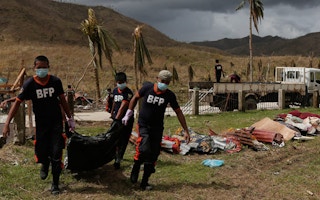Typhoon Haiyan speaks to us of climate inaction, injustice, apathy and irresponsibility.
Enough with all the suffering, enough with this madness. When will they listen? When there will be no people to listen to? When our voices are buried with the rubble left by storm surges and strong winds?
As help from different parts of the globe arrives, we are thankful for the the sympathy - but what we need most is empathy. After global assistance has been delivered, states emitting large amount of carbon dioxide may still remain business as usual.

US government’s NOAA image for sea-surface temperatures on November 2, showing readings near the Philippines well above the 26.5 degrees needed for a typhoon or cyclone to form.
They must submit themselves to a legally binding commitment to reduce carbon emissions, or else we will expect more typhoons which are larger and more intense.
“
Our islands, in 2008, suffered the deluge brought by Typhoon Fengshen. In 2009, Typhoons Ketsana and Parma; followed by Megi in 2010; then, Nesat and Washi in 2011; Bopha in 2012 - and now Haiyan, with an estimated damage of about $14 billion
This is the price of carbon, but we are confused - why are we the ones paying almost every year? We continue to seek climate justice. Climate debt must be settled.
Our islands, in 2008, suffered the deluge brought by Typhoon Fengshen. In 2009, Typhoons Ketsana and Parma; followed by Megi in 2010; then, Nesat and Washi in 2011; Bopha in 2012 - and now Haiyan, with an estimated damage of about $14 billion.
Haiyan is the worst of that cluster. And, as it lashed our communities, affecting millions of innocent people, it may finally exhaust our unique Filipino resiliency.
We thank the world for their kindness but we expect developed countries to take ambitious steps to prevent more Haiyans. We have suffered enough.
For four years, since 2009, I have worked with the communities living in Manicani and Homonhon Islands off Guiuan town in Eastern Samar. I haven’t heard anything about them since Haiyan hit the islands.
I haven’t heard about our partner community in MacArthur, Leyte. I am worried and I mourn. The devastation is beyond imagination, beyond compare.
In my province of Romblon, where I decided to stay, the disaster risk reduction and management council was also hard hit by Haiyan. That’s especially so for the island of San Jose, the southern areas in Tablas Island and Sibuyan Island.
Almost 6000 households were partially damaged and around 750 families are without homes. The local government estimated the damage to around 80 million Philippine pesos ($2 million).
But there are small Philippine islands most people have never heard of that were smashed by Haiyan. So, an initiative to adopt a small island has commenced.
Our climate leaders here in the Philippines are doing all their best on how to help and assist. Brother Jaazeal Jakosalem and Father Manny Bolilia will be going to Tacloban City this weekend for a faith mission called “Spiritual Marines”.
They aim to bless the dead and spiritually uplift the survivors.
With their religious congregation, they have established the Heartanonymous campaign for relief efforts. Now a local public official, Miguel Magalang, is starting a national initiative to re-orient a controversial pork barrel fund known locally as PDAF, to turn it into a disaster relief fund.
Attorney Christina Barroga is exploring how to raise the recent cyclonic event at the International Criminal Court.
You see, for us this a crime - a climate crime - and we will be seeking climate justice.
With this catastrophic reality, human beings here in the Philippines have now become an endangered species.
Rodne Galicha is a district manager in the Philippines for The Climate Reality Project, overseen in Asia by the Australian Conservation Foundation. He is currently based at a disaster relief centre on Romblon, one of the smaller Philippine islands devastated by typhoon Haiyan which tore through the region a week ago. This post originally appeared here.










